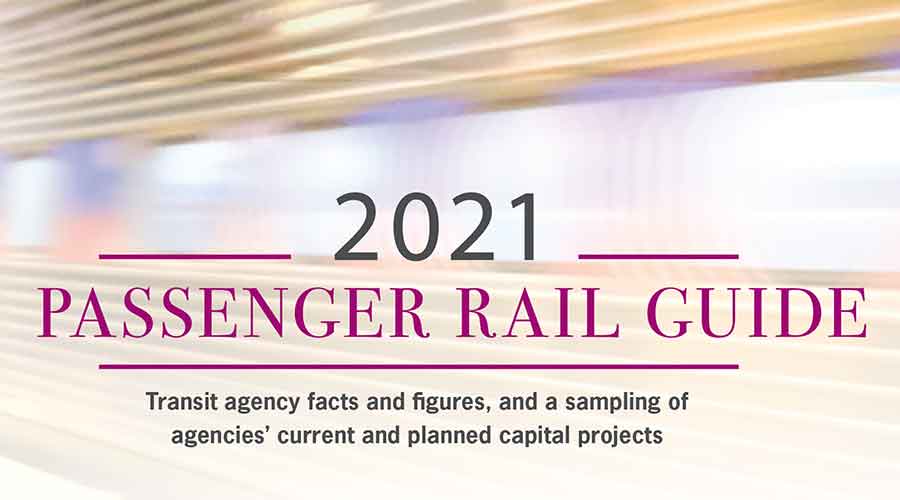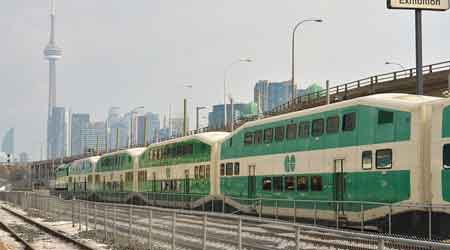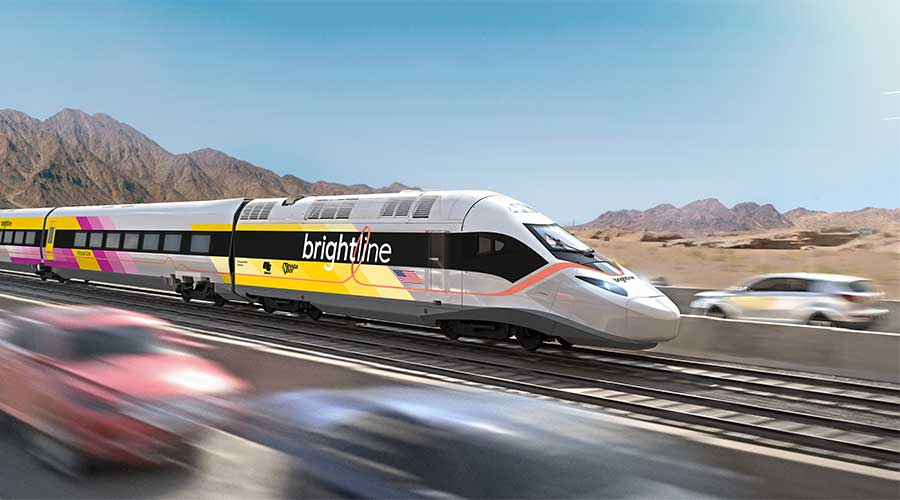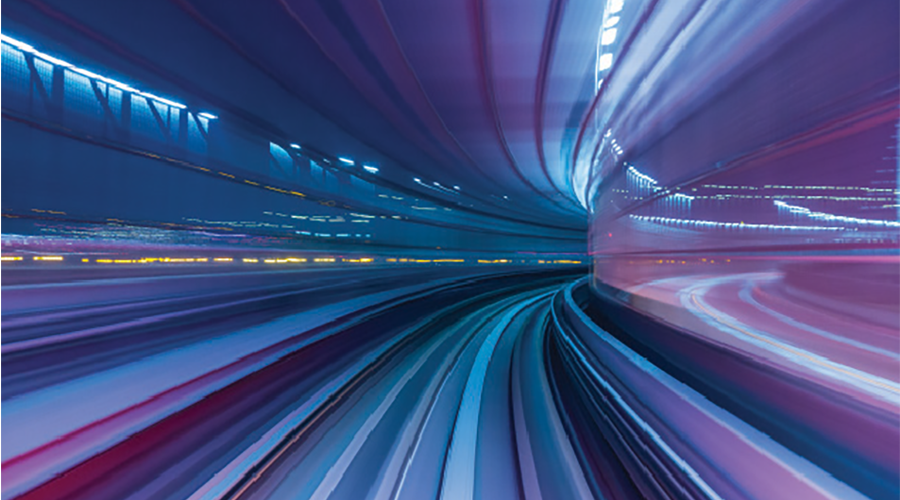Stay updated on news, articles and information for the rail industry
October 2021
Rail News: Passenger Rail
Passenger Rail Guide 2021: Transit agency facts, figures and current projects

Welcome to the 2021 Passenger Rail Guide, which features a sampling of the many agencies that operate passenger-rail service in major U.S. and Canadian cities. The information in this year’s guide comes from responses to a Progressive Railroading survey.
Without question, the stress and strain that most agencies have been operating under since the COVID-19 virus was declared a pandemic in March 2020 has continued through 2021. After a drastic falloff last year following government-ordered shutdowns, transit-rail ridership is returning slowly, especially as many commuters and riders have yet to return to offices and worksites. What that trend might mean over the long term is uncertain.
For example, ridership on Metrolinx GO Transit, which serves the greater Toronto area, plummeted to 90% of pre-pandemic levels.
“We anticipate full recovery will take a few years and may look somewhat different as many office workers adopt a hybrid working model, staggered work hours beyond the traditional 9-to-5 model, and put a greater emphasis on connecting with family and friends,” officials at Metrolinx, the parent agency of GO Transit and UP Express, stated in their survey.
Although a hit to fare revenue, reduced train schedules over the past 19 months have enabled some agencies to speed up timelines for conducting maintenance-of-way and other capital work.
Meanwhile, agencies continue to take numerous steps to safeguard passengers so that they feel confident riding trains. Chicago commuter railroad Metra, for instance, has implemented new disinfecting and deep-cleaning practices, installed hospital-grade filters to capture airborne particles on trains; offered a “touchless” fare payment app; created a “ridership dashboard” to indicate how crowded trains are and added extra trains as needed so that riders can maintain physical distance from each other.
It’s remained unclear throughout 2021 when the pandemic will finally end. What is clear is that COVID-19 has had an unprecedented impact on the passenger-rail industry. What’s to come for the industry heading into 2022? Stay tuned.
— Julie Sneider, Senior Associate Editor
Greater Cleveland Regional Transit Authority (GCRTA)
Formed in 1975 to provide public transportation services to Cuyahoga County in northeast Ohio, the agency’s services include light and heavy rail, bus and paratransit modes.
Service launched: Light rail, 1913; heavy rail, 1955.
Route miles: Light rail, 18; heavy rail; 19.
Rolling stock: 1 locomotive; 51 rail cars, average age 36; 39 light-rail vehicles, average age 40.
Cars/locomotives on order: Rail-car bid invitation for 24 vehicles anticipated in late 2021. GCRTA plans to purchase new light-rail vehicles to serve the Red Line and make associated infrastructure upgrades to its rail maintenance facility, MOW equipment and stations to accommodate the new vehicles. New locomotive procurement in progress.
Annual ridership: Heavy rail (Red Line): 5,666,706 in 2019; 2,638,201 in 2020; 1,124,796, Jan. 1-June 30, 2021; light rail (Blue/Green/Waterfront): 1,484,863 in 2019; 589,245 in 2020; and 260,749 Jan. 1-June 30, 2021.
Annual rail operating budget: $40 million
Annual rail capital budget: $32 million
Rail stations: 56
Major capital projects: Light-rail track rehabilitation: Buckeye to Shaker Square, $8 million; Red Line curve replacement, East 55th to Kinsman Road $1.3 million; Red Line rail grinding, construction estimate TBD; fiber optic system improvements, $6 million; West 117th substation renewal, $2.1 million; Waterfront Line Bridge rehabilitation cost TBD; Warrensville, Van Aken substation replacement, $3 million; West 117th Bridge/Station platform repairs, $6.2 million; West 30th substation renewal, $2 million; Cuyahoga Viaduct rehabilitation, $6.2 million; Tower City East Portal rehabilitation, $10 million; East 75th light-rail interlocking track/switch machine renewal, cost TBD; Warrensville, Van Aken light-rail station/track and crossover renewal, cost TBD; light-rail Trunk Line signal system replacement, $3 million.
Los Angeles County Metropolitan Transportation Authority (L.A. Metro)
L.A. Metro is the public transportation agency for Los Angeles County. It was formed in 1993 out of a merger of the Southern California Rapid Transit District and the Los Angeles County Transportation Commission. L.A. Metro directly operates bus, light rail, heavy rail and bus rapid-transit services. It provides funding and directs planning for commuter rail and freeway/expressway projects within Los Angeles County.
Service launched: Light rail, 1990; heavy rail, 1993.
Route miles per mode: Light rail, 83.6; heavy rail, 14.
Rolling stock: 102 rail cars; 187 light-rail vehicles.
No. cars/locomotives on order: 112
Ridership: July 2021: light rail, 2,345,889; heavy rail,1,787,295. August 2021: light rail, 2,430,109; heavy rail, 1,853,861.
Annual rail operating budget: $421,499,655
Annual rail capital budget: $201,979,068
Stations: Light rail, 93 including 2 shared with heavy rail; heavy rail, 16.
Metrolinx

Metrolinx is an agency of the Ontario government, established under the Metrolinx Act of 2006. The act mandates Metrolinx to coordinate, plan, finance, develop and implement an integrated transit network in the Greater Golden Horseshoe. Metrolinx is responsible for the operation of the regional transit system.
Commuter-rail service launched: GO Transit, an operating division of Metrolinx, launched service in 1967. UP Express, which connects Toronto Pearson International Airport and Union Station in downtown Toronto, launched in 2015.
GO Transit route miles per mode: 83,919
UP Express route miles per mode: 15.5 miles one way to Pearson, 31 miles round trip; rolling stock, 18.
Ridership (as of 2021): Since March 2020, as the pandemic hit, transit ridership plummeted and for most months was below 90% of pre-pandemic levels. Weekend ridership is returning the fastest. At times, the agency is registering ridership at 40% to 50% of pre-pandemic levels, as riders take trips to see family and friends or visit tourist attractions around the province, and attend sporting events. GO Transit trains and buses are beginning to see increased ridership, which is why the agency has returned most service and added some new options. The most recent data shows an average morning peak ridership of 12.6%, and an overall weekday ridership average of 16.6%. With the return of airline flights, UP Express ridership is currently at 20% above pre-pandemic levels.
Operating cost: CA$1.2 billion (FY2020-21.)
Capital budget: CA$3.9 billion (FY2020-21).
Stations: GO Transit, 69; UP Express, two UP and two joint UP/GO.
Major projects:
• GO Expansion On-corridor Works, in procurement. Cost: CA$15.7 billion. The project consists of the core infrastructure and services that will allow Metrolinx’s rail corridor to run two-day, all-day service at a frequency of every 15 minutes, throughout the Greater Toronto and Hamilton Area network.
• GO Expansion-Early Works. Cost: CA$10.5 billion.
There are over 50 individual projects included in the early works program, including several smaller projects delivered as design-build or design-bid-build, along with eight larger projects delivered as build-finance and design-build-finance. The latter includes the Davenport Diamond Rail grade separation project; the Highway 401 Rail Tunnel, which was substantially completed in August 2021; and the Stouffville Corridor Stations improvement project. The program also includes infrastructure renewal at Union Station, including construction of a new South Concourse, track expansion east of the station and replacement of the 90-year-old signaling system with new state-of-the-art signals, communications, power supply, CCTV and SCADA systems.
• GO Expansion-Off Corridor. Cost: CA$619 million. These projects for the GO Expansion are the smallest of the three sections of the expansion project.
• Bowmanville Extension project. Cost: CA$655 million. Announced in June 2016, the project involves extending the Lakeshore East line nearly 12.4 miles from Oshawa to Bowmanville and includes four new stations. Service opens in 2024.
• Kitchener Extension. Cost: CA$959 million. Substantial completion TBD. The Kitchener GO extension will enhance service over its outermost segment to offer a versatile regional travel option that runs outside rush hour.
Metropolitan Atlanta Rapid Transit Authority (MARTA)
MARTA provides 95% of the public transit trips in the metro Atlanta region with 110 fixed bus routes, 38 heavy rail stations, 2.7 miles of light rail, and on-demand paratransit services. MARTA is primarily funded by a 1% sales tax in Fulton, DeKalb and Clayton counties, and a 1.5% sales tax in the city of Atlanta.
Rail service launched: Heavy rail, 1979; light rail, 2014. (MARTA assumed operations from the city of Atlanta in 2018.)
Route miles: Heavy rail, 48 service miles/122 miles of track; light rail, 2.7 miles.
Rolling stock: 312 rail cars, average age is 31.8 years; 3 locomotives, average age is 42 years; 4 light rail vehicles, average age is 6 years.
Cars/locomotives on order: 254 rail cars, manufactured by Stadler.
Rail ridership: 61,778,142 in 2019; 24,056,230 in 2020; 11,920,133 January-July 2021.
Annual rail operating budget: $155.3 million
Annual rail capital budget: $290 million
Rail stations: 38 heavy-rail stations; 12 light-rail stops/station.s
Capital improvement projects:
• TR IV – Track Renovation (Phase IV), which is underway. Replace or renovate components of the rail system. Most work will focus on the North, Northeast and East-West lines. Total cost: $133.6 million. Prime contractor: RailWorks.
• Traction power substation (TPSS) replacement program. The project will start in spring 2022 and involve replacing aging end-of-life TPSS equipment. Timing and sequencing will be determined by available budget and prioritization of need. Total cost: $27 million to $32 million. Preparing procurement of Wave I.
• Train Control Scada Upgrade, slated for June 2022 completion. Upgrade, replace IOC train control system. Estimated cost: $120 million. Prime contractor: Alstom.
• CQ400 new rail cars, which is underway. MARTA entered a contract to purchase 254 rail cars from Stadler US in November 2019 for $646 million. The contract includes an option for MARTA to purchase an additional 100 rail cars. The first new rail car is scheduled to arrive in 2023.
New Jersey Transit
NJ Transit is the nation’s largest statewide public transit system, providing more than 925,000 weekday trips on bus, light rail, rail and Access Link systems.
Service launched: Light rail, 1930s; commuter rail, 1979.
Route miles: Light rail, 116 directional route miles; commuter rail, 545.
Rolling stock: 154 locomotives, average age is 31.5 years; 1,040 rail cars, average age is 23.5 years; 93 LRVs, average age is 19 years.
Cars/locomotives on order: 113 multilevel III cars built by Alstom; 23 ALP-45A Dual Power locomotives built by Alstom.
Annual ridership: Light rail: 11.9 million in FY21; 18.6 million in FY20. Commuter rail: 19.1 million in FY21; 65.1 million in FY20.
Annual operating rail budget: $995-million (estimated FY22).
Rail stations: 166
Major capital projects:
• Portal North Bridge. Project is advancing. Cost: $1.8 billion.
• Raritan River Bridge. Project broke ground in September 2020. Cost: $600 million.
• $4 billion in projects underway or entering procurement since 2018, a 65-times increase from $60 million in hard-money contracts in 2017.
• Launch of the agency’s first-ever strategic plan, NJT 2030: A 10-Year strategic plan and 5-Year capital plan.
Northeast Illinois Commuter Railroad Corp. (Metra)
Metra is the Chicago region’s commuter railroad operator, providing service over 11 lines in six counties.
Service launched: 1984
Route miles: 488
Rolling stock: 173 locomotives; 861 diesel passenger cars; 186 electric-propelled passenger rail cars.
Cars/locomotives on order:
• In February 2019, Metra’s board approved a $70.9 million contract to purchase 15 remanufactured EMD SD70MAC freight locomotives to begin to replace Metra’s aging fleet. The contract with Progress Rail Locomotives includes options to buy up to 27 additional locomotives, if funding is available.
• In January 2021, Metra’s board approved the purchase of up to 500 state-of-the-art rail cars from Alstom Transportation Inc., opting for new multilevel cars. The initial order will be for 200 cars. Metra will have the option to buy up to 300 additional cars for up to $1.8 billion total.
• In February 2021, Metra’s board approved the issuance of a request for proposal (RFP) for the purchase of seven new low-emission switch locomotives, including the railroad’s first zero-emission electric-powered unit. The other six units will be required to meet EPA Tier IV emission standard. Results of the RFP have yet to be announced.
Annual ridership: 74,043,516 in 2019; 18,611,311 in 2020; 2021 ridership is currently at about 25% of pre-pandemic levels and is forecasted to be at 30% by the end of the year.
Annual operating budget: $700 million (2021)
Annual capital budget: $386.9 million (2021)
Stations: 242, including 5 stations (4 terminals) in downtown Chicago.
Major capital projects underway or scheduled to begin:
• Auburn Park Station and EW-2 bridge lift: Construct a new station in the Auburn Park neighborhood on Metra’s Rock Island Line. A $28.2 million contract has been awarded to John Burns Construction to build the station and a parking facility.
• Peterson Ridge Station: Construct a new station on the Union Pacific North Line at Peterson and Ridge avenues. A $15.2 million contract was awarded to John Burns Construction to build the station and a parking facility.
• A-32 Bridge and Grayland Station: Replace a railroad bridge over Milwaukee Avenue on Chicago’s northwest side that was built in 1899. The new double-track bridge will have a ballasted deck, requiring that the tracks and platforms at the adjacent Grayland Station be raised. The work at Grayland Station will also include a new passenger shelter, ramps and stairs. In addition, the bridges over Addison Street and Irving Park Road will be repaired. A $27 million contract was awarded to IHC Construction Companies LLC. The project is being funded with a combination of federal formula funds and a $17.8-million federal grant.
• 147th Street/Sibley Boulevard Station: Replacement of the platform, head house and construction of a drop-off on the west side of the station on Metra’s Electric Line. Final costs TBD. Project went out to bid in the summer 2021 and is expected to be awarded by yearend.
• Vermont Street Station: Renovation of the historic on the Rock Island Line in Blue Island, Illinois. Structure dates to 1868. Final costs TBD. Project went out to bid in the summer 2021 and is expected to be awarded by yearend.
• Westmont Station: Replace platforms and add new technology to this station on the BNSF Line. The project will include repairs to stairs and improvements to the station’s ADA features. The 2021 capital program allocated $2 million in federal state-of-good repairs funds to the project. Final costs TBD.
• 95th Street Station: Build a new station and parking facility on the campus of Chicago State University to replace the existing station at 95th Street on the Metra Electric Line. Project is in design but expected to go out to bid soon. Final costs TBD.
Regional Transportation District-Denver (RTD)
The RTD develops, operates and maintains a public transportation system that meets the transit needs of close to 3 million people within an eight-county service area in the Denver metro region. Pre-pandemic, RTD’s buses, rail lines, shuttles and additional services provided approximately 100 million annual passenger trips.
Service launched: Light rail, 1994; commuter rail, 2016.
Route miles per mode: Light Rail, 60; commuter rail, 53.
Rolling stock: 60 commuter rail cars, average age 4 years; 201 light-rail vehicles, average age 12 years.
Annual ridership: 2019, 105,823,892; 2020, 52,616,640; and June 2021, 20,688,204.
Annual rail operating budget: $150,657,947 (excluding depreciation) in 2021.
Annual rail capital budget: $48.5 million in 2021.
Rail stations: 57 light rail stations and 23 commuter rail stations.
Major capital projects: State-of good-repair rail replacements through downtown Denver. Anticipated budgets $50,000 to $500,000.
Trinity Metro
Trinity Metro was created in 1983 as a regional transportation authority of the state of Texas. The agency’s rail services include TEXRail and Trinity Railway Express (TRE). TEXRail, which operates between Fort Worth and Dallas Fort Worth International Airport’s Terminal B, is solely owned and operated by Trinity Metro. TRE, which runs between Fort Worth and Dallas, is jointly owned and operated by Trinity Metro and Dallas Area Rapid Transit.
Year service launched: 1983
Route miles: TEXRail, 27.2 total route miles in 2020; TRE, 34 total route miles.
Rolling stock: TEXRail: 8 sets; TRE: 9 locomotives, 8 cab cars, 17 coaches.
Annual ridership: TEXRail 363,687, TRE 1,675,520 in 2019; TEXRail 304,196, TRE 1,143,105 in 2020; TEXRail 234,109 TRE 633,800 in 2021.
Annual operating budget: TEXRail, $29.5 million; TRE 16.6 million.
Annual capital budget: TEXRail and TRE, $42.4 million (anticipated 2022 expenditures).
Stations: TEXRail, 9; TRE, 10.
Major capital projects: TRE Medical District Drive; TRE Crossing Improvements at Market Center Boulevard; Trinity Lakes Station, Fort Worth; Calloway Cemetery Crossing, Fort Worth.
Valley Metro
Valley Metro provides bus and light-rail service in Maricopa County, Arizona. Progress continues on five high-capacity transit extensions that are either in planning or under construction to create a 50-mile rail system by 2030. In late 2021, Valley Metro will open the region’s first streetcar line in Tempe that features the Valley’s first off-wire operations in the system.
Launched: Light rail, 2008.
Route miles: Light rail, 28 miles.
Rolling stock: 49 LRVs in revenue servic.e
Cars/locomotives on order: 25 LRVs, 6 streetcars
Ridership: 64.4 million, FY 2019 (July 1-June 30); 52.4 million, FY2020; 27.3 million, FY2021.
Annual rail operating budget: $78.9 million
Annual rail capital budget: $366.7 million
Rail stations: 35
Major projects underway:
• South Central Extension/Downtown Hub, a 5.5-mile extension that will connect with the current light-rail system in downtown Phoenix and operate south on Central Avenue to Baseline Road. The project also includes a light-rail transit hub in downtown Phoenix, 8 stations and 2 park-and-rides. Contractor: Kiewit. Cost: $1.3 billion.
• Tempe Streetcar, the first modern streetcar line in the Valley. The 3-mile line will feature 14 stops and 2 connections to Valley Metro. Contractor: Stacy Witbeck Sundt JV. Total cost: $192.4 million.
• Northwest Extension Phase II, which will extend light rail west on Dunlap Avenue from 19th Avenue, then north on 25th Avenue and across I-17 on Mountain View Road with a terminus on the west side of the freeway near Metrocenter Mall. At the end-of-line, the Metrocenter Station will be the first elevated station in Valley Metro’s light-rail system. The extension will be 1.6 miles long with 3 stations. Contractor: Kiewit McCarthy JV. Total cost: $401.3 million.
Virginia Railway Express
Commuter-rail system connecting Central and Northern Virginia with Washington, D.C.
Service launched: 1992
Route miles: 82
Rolling stock: 20 locomotives, MP-36; 21 Gallery IV cab cars, 49 Gallery IV trailers with no restroom; 30 Gallery IV trailers with no restroom.
Locomotives on order: 21
Annual ridership: FY 2019, 4.5 million (July to June pre-pandemic ridership); FY 2020, 3.2 million (July to February pre-pandemic ridership, and March to June pandemic ridership); FY2021, 342,009 July to June pandemic ridership); and FY2022, 144,000 (July to September pandemic ridership).
Annual operating budget: $89.7 million
Annual capital budget: $96.2 million
Rail stations: 19 (6 Manassas Line/9 Fredericksburg Line/4 core shared)
Major capital improvement projects underway or scheduled to begin: VRE’s capital improvement program includes 30 projects ranging from station and parking improvements to maintenance and storage facilities to new rolling stock. To date, 85% of the $816.8 million needed for the projects is funded.
Under construction:
• Lifecycle Overhaul and Upgrade Facility (LOU). Featuring 33,000 square feet of maintenance space, the LOU will allow VRE to maintain rolling stock, systems and components in a state of good repair. The LOU will house two tracks, holding up to four cars at one time, and be equipped with a drop table and wheel truing machine. To maintain storage capacity within the yard, three new tracks will provide enhanced flexibility for train movements and storage. Cost: $52.2 million. Contractors: Clark Construction, Gannett Fleming. Completion: Q1 2023.
• Quantico Station improvements: Construction of a new center platform, ADA-compliant pedestrian bridges, existing platform extension and third track. The improvements will allow additional passengers and more frequent and longer trains. Cost: $24 million. Contractors: Archer Western and Dewberry. Completion: Q3 2023.
• Rolling Road Station improvements: An extended platform will accommodate eight-car trains. Rehabilitation and repair of the existing platform, replacement of stairs and the existing canopy roof, and an upgrade of the lighting and communication systems are planned. Cost: $5 million. Contractors: Sumter Contracting Corp., STV Inc.
Keywords
Browse articles on Progressive Railroading Passenger Rail Guide Greater Cleveland Regional Transit Authority Los Angeles County Metropolitan Transportation Authority Metrolinx GO Transit UP Express Metropolitan Atlanta Rapid Transit Authority Metra Regional Transportation District-Denver Trinity Metro Valley Metro Virginia Railway ExpressContact Progressive Railroading editorial staff.


 LRW Honors Amtrak’s Acheson As Railway Woman Of The Year
LRW Honors Amtrak’s Acheson As Railway Woman Of The Year
 From Editor-In-Chief Foran: Of Gender Equity And Inclusion
From Editor-In-Chief Foran: Of Gender Equity And Inclusion
 Spotlight On Some Of Today’s Rail Safety Products
Spotlight On Some Of Today’s Rail Safety Products
 Women of Influence in Rail eBook
Women of Influence in Rail eBook
 railPrime
railPrime







